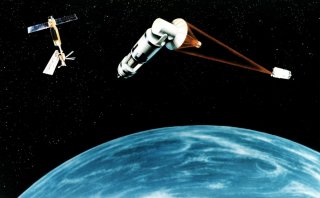Project Icarus: In Case of Armageddon NASA Had an Action Plan
Here’s hoping no hazardous interstellar object never requires launching nukes into space.
Here's What You Need to Remember: The final plan created by the students at MIT involved sending a series of six or seven nuclear-armed missiles towards 1566 Icarus in succession. Each of the missiles represented a chance to save Earth, with the first missile launched perhaps a couple of months before estimated impact, and the final opportunity a mere 18 hours before 1566 Icarus hit Earth.
President: What is this thing?
Truman: It’s an asteroid, sir.
President: How big are we talking?
Scientist: Sir, our best estimate is 97.6 billion—
Truman: It’s the size of Texas, Mr. President.
President: Dan, we didn’t see this thing coming?
Truman: Well, our object collision budget’s about a million dollars a year. That allows us to track about three percent of the sky, and begging your pardon, sir, but it’s a big-ass sky.
Gen. Kimsey: And the ones this morning?
Truman: Uh, those were nothing. Those were the size of basketballs and Volkswagens, things like that.
President: Is this, going to hit us?
Truman: We’re efforting that as we speak, sir.
President: What kind of damage will this do?
Truman: Damage? Total, sir. It’s what we call a global killer. The end of mankind. Doesn’t matter where it hits, nothing would survive, not even bacteria.
President: My God. What do we do?
This dialogue is from the 1998 hit film Armageddon, in which a team of drillers are sent by NASA to blow up an incoming asteroid that is on course to destroy all life as we know it. But what would NASA do if a global killer actually was headed our way?
Project Icarus
A thought experiment conducted at the Massachusetts Institute of Technology in the 1960s posed students with a question. What would you do if 1566 Icarus was headed to earth on an impact trajectory? How would you deflect the asteroid?
1566 Icarus is nearly mile-wide asteroid that follows an eccentric orbit in our solar system, crossing the orbits of Mercury, Venus, Mars—and Earth. Thanks to its invasive orbit, 1566 Icarus is classified as a potentially hazardous object, essentially an extraterrestrial object with the potential to cause serious damage on Earth. Though 1566 Icarus is nowhere near the size of Texas, it could cause significant damage if it impacted the Earth.
Its 1996 approach was 10 million miles from Earth—close on the cosmic scale, and close enough to make some important observations. Using radar, 1566 Icarus was scanned and became the first radar-observed asteroid. In 2015, 1566 Icarus’ orbit was half as far, just a mere 5 million miles from Earth. To put that into perspective, Mars is roughly 49 million miles from the Earth on average.
Hypervelocity Asteroid Intercept Vehicle
The students at MIT had a plan: blow it up with a nuclear bomb. Yes, really.
Students hypothesized that some of NASA’s heavy-lift Saturn V rockets would be able to carry a nuclear device close to 1566 Icarus’ orbit and detonate just before impact. The students thought that a 100 megaton nuclear bomb would be sufficient to alter the mile-wide asteroid’s orbit away from Earth. There was, however, a small problem.
The most powerful nuclear weapon ever manufactured by the United States was the B41 nuclear bomb. It had a quarter of the destructive power needed to shift 1566 Icarus’ orbit, a paltry 25 megatons. Even the Soviet Union, the creator of some of the most powerful nuclear weapons ever fell short. The Tsar Bomba was the largest nuclear explosion ever and the largest man-made explosion on Earth. It was detonated in 1961 by the Soviet Union—and had a yield of just 50 megatons, half of what MIT estimated would be required to shift 1566 Icarus.
They also calculated there would be a small chance of merely fragmenting 1566 Icarus into multiple pieces without altering the asteroid’s trajectory. This scenario would have actually been more destructive. It was estimated that the project would have an approximately 70-80% chance of success.
Postscript
The final plan created by the students at MIT involved sending a series of six or seven nuclear-armed missiles towards 1566 Icarus in succession. Each of the missiles represented a chance to save Earth, with the first missile launched perhaps a couple of months before estimated impact, and the final opportunity a mere 18 hours before 1566 Icarus hit Earth. Here’s to hoping 1566 Icarus—or any other potentially hazardous interstellar object never requires launching nukes into space.
Caleb Larson holds a Master of Public Policy degree from the Willy Brandt School of Public Policy. He lives in Berlin and writes on U.S. and Russian foreign and defense policy, German politics, and culture.
Image: Public Domain Archive

